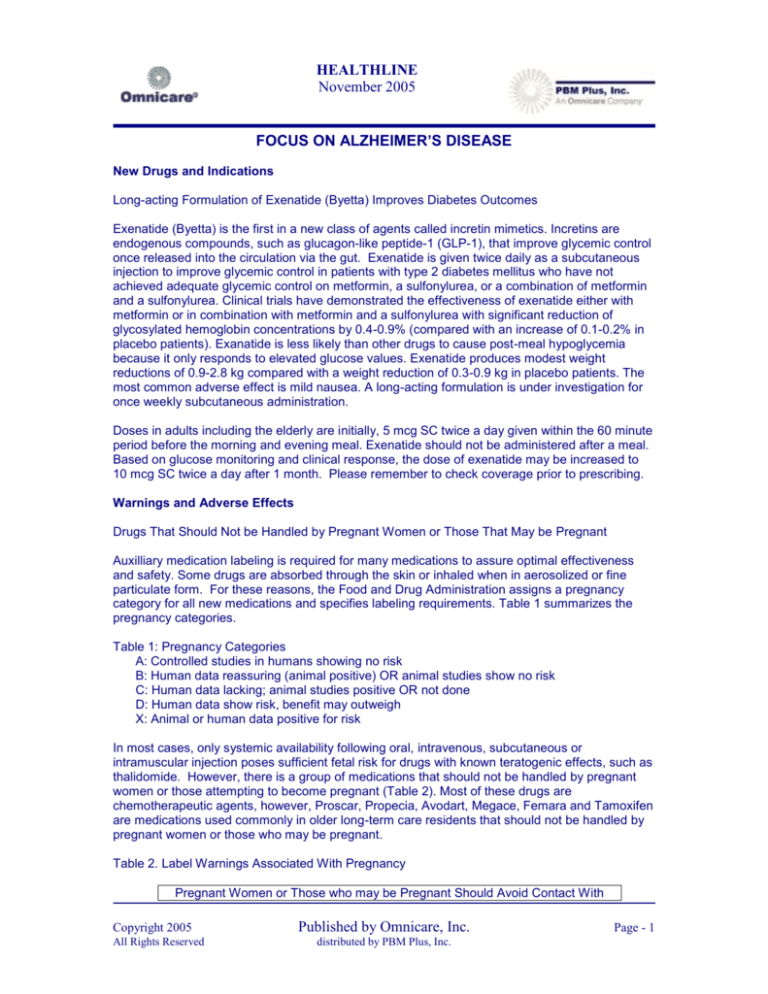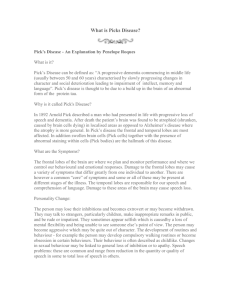
HEALTHLINE
November 2005
FOCUS ON ALZHEIMER’S DISEASE
New Drugs and Indications
Long-acting Formulation of Exenatide (Byetta) Improves Diabetes Outcomes
Exenatide (Byetta) is the first in a new class of agents called incretin mimetics. Incretins are
endogenous compounds, such as glucagon-like peptide-1 (GLP-1), that improve glycemic control
once released into the circulation via the gut. Exenatide is given twice daily as a subcutaneous
injection to improve glycemic control in patients with type 2 diabetes mellitus who have not
achieved adequate glycemic control on metformin, a sulfonylurea, or a combination of metformin
and a sulfonylurea. Clinical trials have demonstrated the effectiveness of exenatide either with
metformin or in combination with metformin and a sulfonylurea with significant reduction of
glycosylated hemoglobin concentrations by 0.4-0.9% (compared with an increase of 0.1-0.2% in
placebo patients). Exanatide is less likely than other drugs to cause post-meal hypoglycemia
because it only responds to elevated glucose values. Exenatide produces modest weight
reductions of 0.9-2.8 kg compared with a weight reduction of 0.3-0.9 kg in placebo patients. The
most common adverse effect is mild nausea. A long-acting formulation is under investigation for
once weekly subcutaneous administration.
Doses in adults including the elderly are initially, 5 mcg SC twice a day given within the 60 minute
period before the morning and evening meal. Exenatide should not be administered after a meal.
Based on glucose monitoring and clinical response, the dose of exenatide may be increased to
10 mcg SC twice a day after 1 month. Please remember to check coverage prior to prescribing.
Warnings and Adverse Effects
Drugs That Should Not be Handled by Pregnant Women or Those That May be Pregnant
Auxilliary medication labeling is required for many medications to assure optimal effectiveness
and safety. Some drugs are absorbed through the skin or inhaled when in aerosolized or fine
particulate form. For these reasons, the Food and Drug Administration assigns a pregnancy
category for all new medications and specifies labeling requirements. Table 1 summarizes the
pregnancy categories.
Table 1: Pregnancy Categories
A: Controlled studies in humans showing no risk
B: Human data reassuring (animal positive) OR animal studies show no risk
C: Human data lacking; animal studies positive OR not done
D: Human data show risk, benefit may outweigh
X: Animal or human data positive for risk
In most cases, only systemic availability following oral, intravenous, subcutaneous or
intramuscular injection poses sufficient fetal risk for drugs with known teratogenic effects, such as
thalidomide. However, there is a group of medications that should not be handled by pregnant
women or those attempting to become pregnant (Table 2). Most of these drugs are
chemotherapeutic agents, however, Proscar, Propecia, Avodart, Megace, Femara and Tamoxifen
are medications used commonly in older long-term care residents that should not be handled by
pregnant women or those who may be pregnant.
Table 2. Label Warnings Associated With Pregnancy
Pregnant Women or Those who may be Pregnant Should Avoid Contact With
Copyright 2005
All Rights Reserved
Published by Omnicare, Inc.
distributed by PBM Plus, Inc.
Page - 1
HEALTHLINE
November 2005
These Medications
Generic Name
Brand Name
Testosterone
Testosterone/Androderm/Androgel
Testosterone Propionate
Testosterone Propionate
Testosterone Ointment/Cream
First Testosterone
Cyclophosphamide
Neostar/Cytoxan
Chlorambucil
Leukeran
Melphalan
Alkeran
Busulfan
Myleran/Busulfex
Thioguanine
Thioguanine Tabloid
Mitotane
Lysodren
Tamoxifen Citrate
Tamoxifen
Nilutamide
Nilandron
Megestrol acetate
Megace
MESNA
Mesnex
Bicalutamide
Casodex
Anastrozole
Arimedex
Letrozole
Femara
Methotrexate Sodium
Methotrexate/Folex-PFS/Trexall/Rheumatex
Capecitabine
Xeloda
Exemastane
Aromasin
Fludarabine Phosphate
Fludarabine
Hydroxyurea
Hydrea/Droxia/Myocel
Imatinib Mesylate
Gleevec
Geftinib
Iressa
Dutasteride
Avodart
If Crushed Prior to Administration, Must Not Be Handled by Women Who Are
Pregnant or Who May Become Pregnant
Nilutamide
Nilandron
Bicalutamide
Casodex
Finasteride
Proscar/Propecia
PATIENT CARE: A Primer on Alzheimer’s Disease in the Elderly
Background
An estimated 4.5 million Americans have Alzheimer’s disease (AD), and 250,000 new cases
occur each year. According to the federal 2002 National Vital Statistics Report, AD is the nation’s
4th leading cause of death among all persons. It is the 9th leading cause of death in men and the
5th leading cause of death in women among persons 65 years and older. Approximately half of
residents in long-term care facilities have dementia or AD, and dementia is the most common
reason for admission to a skilled nursing facility. AD typically runs a course of 3-20 years
between onset and death, with the average course lasting 10 years. It is important to note that
while it is a leading cause of death, patients do not die from neurodegeneration but from the
consequences: malnutrition, infection, and aspiration pneumonia.
Diagnosis
AD results in impaired recent memory, word finding, general intellect, visuospatial processing,
memory recognition, and apraxia. DSM-IV criteria for AD include memory impairment and one or
more cognitive disturbances as outlined in Table 1. These conditions must cause significant
impairment in social or occupational functioning, represent a significant decline from a previous
level of functioning, and are not due to a CNS or other physical condition or Axis I disorder.
Copyright 2005
All Rights Reserved
Published by Omnicare, Inc.
distributed by PBM Plus, Inc.
Page - 2
HEALTHLINE
November 2005
Table 1: Diagnostic Criteria for Alzheimer’s Disease (DSM IV)
Development of cognitive deficits manifested by both:
o Impaired memory
o Aphasia (difficulty expressing or receiving ideas orally), apraxia (difficulty with
motor activity), agnosia (difficulty with recognition of common items), disturbed
executive function
Significantly impaired social, occupational function
Gradual onset, continuing decline
Not due to CNS or other physical conditions (e.g., Parkinson’s Disease, delirium)
Not due to an Axis I disorder (e.g., schizophrenia)
AD progresses through several clinical stages. Loss of recent memory, or forgetfulness, is the
most common presenting symptom. This is often accompanied, or shortly followed by, personality
and behavioral changes, including disinterest in hobbies and social activities. Complex tasks that
involve executive functioning, such as the management of finances, using household appliances,
and performing household chores, are often impaired early in the disease, whereas basic ADLs,
such as grooming and hygiene, toileting and feeding, are not affected until the dementia is more
advanced. Impaired patients will eventually develop decline in other cognitive realms. These
include navigational ability (visual-spatial function), recognition of common items (agnosis), and
motor programming (praxis). Table 2 reviews the signs and symptoms of Mild, Moderate and
Severe AD.
Table 2: Signs and Symptoms of Alzheimer ’s Disease
Mild
Moderate
-Memory loss and changes in
-Increased memory loss and
expressive speech
shortened attention span
-Confusion about the location of -Difficulty recognizing friends and
familiar places
family
-Taking longer to finish routine,
-Problems with language, including
daily tasks
speech, reading, comprehension, and
-Difficulty with simple math
writing
problems and related issues
-Difficulty organizing thoughts
like handling money, paying
Inability to learn new things or cope
bills, or balancing a checkbook
with unexpected situations
-Poor judgment which leads to
-Restlessness, agitation, anxiety,
bad decisions
tearfulness, and wandering,
-Mood and personality changes especially in the late afternoon or
Increased anxiety
evening
-Repetitive statements or movements
-Hallucinations, delusions,
suspiciousness, or paranoia
-Loss of impulse control (for example,
sloppy table manners, undressing at
inappropriate times or inappropriate
places, vulgar language)
Severe
-Complete loss of language and
memory
-Weight loss
-Seizures, skin infections, and
difficulty swallowing
-Groaning, moaning, or grunting
-Increased sleeping
-Lack of bladder and bowel
control
-Loss of physical coordination
-Unable to perform ADLs
National Institutes of Health, U.S. Dept. of Health and Human Services; 2002. NIH Publication
Number 02-3782.
Copyright 2005
All Rights Reserved
Published by Omnicare, Inc.
distributed by PBM Plus, Inc.
Page - 3
HEALTHLINE
November 2005
Because AD is the most common cause of dementia in the US, it is generally used as the
prototype for guidelines on dementia diagnosis and treatment. However, Alzheimer’s is only one
of a number of such degenerative disorders. There are both potentially reversible and irreversible
conditions that may cause or mimic AD. Not all patients presenting with symptoms have dementia
but may in fact have an underlying condition that may be reversible. These conditions should be
ruled out and corrected before diagnosing AD. Table 3 provides examples of potentially
reversible causes of dementia or dementia like symptoms. It is important to note that medications
may contribute to dementia like symptoms, particularly medications with anticholinergic activity,
such as diphenydramine, hydroxyzine, cyproheptadine, tricyclic antidepressants (e.g.
amitriptyline, doxepin, etc), oxybutynin immediate-release, cimetidine, and codeine. These
medications should be avoided in the elderly and those individuals with known AD and/or being
treated with an acetylcholinesterase inhibitor. The opposing effects between cholinesterase
inhibitors (used to treat AD) and anticholinergic agents may have a significant effect on dementia
and AD.
Table 3: Potentially Reversible Causes of Dementia or Dementia-Like Symptoms
Adverse effects
Hypothyroidism
Nutritional deficiencies Wernicke’s encephalopathy
of medications
Hypoglycemia
Normal pressure
Prion diseases
CNS infections
Malignant
hydrocephalus
e.g., Cretzfeldt-Jakob
Depression
hypertension
Liver failure
disease
Dehydration
B12 deficiency
Systemic infections
Resectable brain tumors
Pain
Syphilis
Uremia
Subdural hematoma
The presence of any of the above symptoms (Table 1 and 2) suggests the need for further
evaluation. Clinical diagnosis of Alzheimer’s can be made with 90% accuracy based on general
medical, neurologic, and psychiatric evaluation and the application of diagnostic criteria from a
prior baseline detailed in Table 1. A thorough clinical assessment and caregiver or family
interview are the most important diagnostic tools for the assessment of the disease, since there
are currently no established laboratory tests that prove diagnosis. If a diagnosis at the time of
assessment remains unclear, a repeat assessment in 3 to 6 months may determine whether
progressive decline characteristic of a neurodegenerative disease has occurred. Screening tools
such as the Mini Mental State Examination (MMSE), the Cognitive Performance Scale (CPS), the
Mini-Cog, and the Clock Drawing Test (CDT) are commonly used scales that are used to
measure cognition, behavior, and functional ability in patients with AD. These tests are easy to
administer, require minimal training and can be completed within 20 minutes.
Treatment Strategies:
A number of nonpharmacologic strategies may aid the management of Alzheimer’s disease.
Environment and behavioral techniques may address specific behaviors and as such compliment
pharmacotherapy. Educating caregivers, maintaining social and family activities as much as
possible, identifying underlying precipitants of troublesome behavior, optimizing sensory input,
arranging regular exercise, employing familiar surroundings, keeping daily activities routine, and
using clocks and calendars to maximize orientation are all excellent example of effective
nonpharmacological strategies that should be employed.
Currently, there is no FDA-approved treatment available to prevent, cure or arrest the progression
of AD. However, as understanding of risk factors grows, there may be ways of reducing personal
risk for the disease that ultimately prevent the onset of the AD. After early symptoms develop, the
goal is to maintain individuals at their highest possible level of functioning. Stopping or slowing
down the usual advance of the disease could theoretically enable individuals to remain
Copyright 2005
All Rights Reserved
Published by Omnicare, Inc.
distributed by PBM Plus, Inc.
Page - 4
HEALTHLINE
November 2005
independent and live in their own homes or maintain function with minimal support for longer
periods of time.
Acetylcholinesterase Inhibitors (AChEIs) are currently approved in the United States for the
treatment of Alzheimer’s disease. There are currently four available in the United States: tacrine
(Cognex), donepezil (Aricept), rivastigmine (Exelon), and galantamine (Razadyne). It is important
to note that galantamine’s trade name is now Razadyne but used to be known as Reminyl. While
the four available AChEIs are all members of a common drug class, they exhibit individual
differences summarized in Table 4. Tacrine is rarely used in clinical practice since better
tolerated agents have been made available. These agents have been studied in Alzheimer’s
patients through various placebo-controlled clinical trials and can provide modest improvement of
symptoms, temporary stabilization of cognition, or reduction in the rate of cognitive decline in
some patients with mild-to-moderate Alzheimer’s disease. Although these positive benefits have
been noted, there are no data which suggest that these agents prolong the lifespan of a patient
with AD. The most common side effects with these medications include gastrointestinal effects
such as nausea, vomiting, anorexia and diarrhea. These adverse effects can be reduced by
initiating therapy at the lowest effective dose and gradually increasing the dose per
manufacturer’s recommendations, and administering the drug on a full stomach. Often patients
will develop a tolerance over time and the effects diminish.
Memantine (Namenda) was approved in October 2003 by the FDA. It is the first Alzheimer drug of
this type approved in the United States and is classified as a N-methyl-D-aspartate (NMDA)
receptor antagonist, also called a glutaminergic agent. It is approved by the FDA for the treatment
of moderate to severe AD.
Table 4: Comparison of Acetylcholinesterase Inhibitors
AChEI
(binding)
Mechanism of
action
Dosing
schedule
Recommended daily
dosage
Halflife
Comments
Tacrine
(Cognex)
Inhibition of AChEI and
BuChEI
4 times
daily
120-160 mg/day (Initial
dose 40 mg/day)
3-5
hours
Used in US as last line
agent due to short half
life and hepatotoxicity
Donepezil
(Aricept)
Inhibition of AChEI
Once daily
Initial dose 5 mg/day
taken at bedtime, after
6 weeks increase to
10mg/day
70
hours
Well tolerated, positive
effects on cognition,
global function, ADL
Rivastigmine
(Exelon)
Inhibition of AChEI and
BuChE
Twice daily
Initial dose 1.5 mg
twice daily, at 2 week
intervals increase dose
by 1.5 mg up to 6 mg
twice daily
1.5
hours
Well tolerated, positive
effects on cognition,
global function, ADL
Galantamine
Razadyne/ER)
Inhibition of AChEI
Allosteric modulation of
nicotinic acetylcholine
receptors
Twice daily
Initial dose 4 mg twice
daily with food, at 4
week intervals increase
each dose by 4 mg up
to 12 mg twice daily
7 hours
Well tolerated, positive
effects on cognition,
global function, ADL,
behavior, caregiver time
AChEI = acetylcholinesterase; BuChEI = butyrylcholinesterase; ADL = activities of daily living
Reichman WE. Ann Gen Hosp Psychiatry 2003;2:1-14.
Current guidelines do not address the long-term use of cholinesterase inhibitors and whether they
should be discontinued in the absence of any measurable effect. It has been proposed that
therapy may continue as long as the resident demonstrates a response and/or clinical status
permits the monitoring for potential adverse effects. The use of memantine in combination with a
Copyright 2005
All Rights Reserved
Published by Omnicare, Inc.
distributed by PBM Plus, Inc.
Page - 5
HEALTHLINE
November 2005
cholinesterase inhibitor seems promising in patients with more advanced AD, however, only one
published trial to date has formally evaluated the use of combination therapy.
Summary:
The burden of care for AD patients is considerable, however, there is no cure for this debilitating
and deadly disease . The most widely studied treatments for AD are the acetylcholinesterase
inhibitors (AChEI) which have been shown to improve cognition, function, and behavior.
Memantine is an option for treating moderate-to-severe AD. The combination of memantine with
AChEI is most promising. Non-pharmacologic interventions remain a mainstay of management of
all individuals with AD and should be employed whenever feasible either alone or in combination
with pharmacologic therapies. As dedicated health care providers for the elderly, our
commitment must reside with providing a safe and comfortable environment to assist in the
maintenance or improvement in the quality of life for those suffering from this disease.
References:
Hebert LE, Scherr PA, Bienias JL, et al. Alzheimer’s disease in the U.S. population: Prevalence
estimates using the 2000 census. Arch Neurol 2003;60:1119-22.
National Nursing Home Survey. National Center for Health Statistics, 1999.
National Vital Statistics Report 2002
Alzheimer’s disease: Unraveling the Mystery. National Institutes of Health, U.S. Dept. of Health
and Human Services; 2002. NIH Publication Number 02-3782.
Thompson American Health Consultants. Primary Care Consensus Reports. Alzheimer’s disease:
Risk stratification, patient evaluation, and outcome-effective pharmacologic therapy – Year 2004
clinical update. June 15, 2004
Geriatric Pharmaceutical Care Guidelines, 2005 Edition.
Editorial Board
Karen Burton, R. Ph., GCP, FASCP
Mark Coggins, Pharm. D., GCP, FASCP
Kelly Hollenack, Pharm. D. CGP
Philip King, Pharm. D., GCP, FASCP
Susan Kleim, B.S., Pharm., GCP, FASCP
Terry O’Shea, Pharm. D., GCP, FASCP
Elmer Schmidt, Pharm. D., GCP, FASCP
Barbara J. Zarowitz, Pharm. D., GCP, FASCP
Copyright 2005
All Rights Reserved
Published by Omnicare, Inc.
distributed by PBM Plus, Inc.
Page - 6








